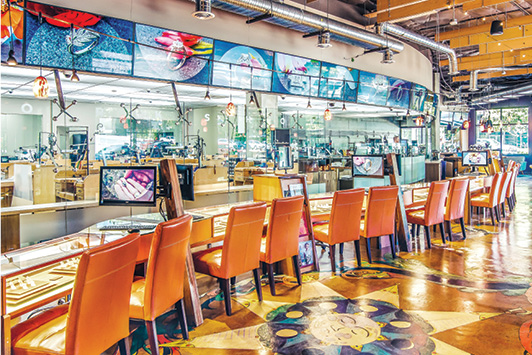
Creating a unique selling proposition is one of the key tenets of successful marketing, and Green Lake Jewelry Works is proof of that principle in action. It has carved its own niche by specializing in custom design at its studios in Seattle and Bellevue, Washington.
“We always knew it was going to be a custom shop,” says president and founder Jim Tuttle. While most jewelers do custom work, he points out, “for us, it is 90% of our business, which gives us a distinct point of differentiation.”
Tuttle, who originally studied industrial engineering, is a self-taught bench jeweler — a process he describes as “training by fire.” When he opened his first studio in Seattle in 1996, it was a one-man shop dedicated to working directly with the public, and “we’ve never stopped.”
Eventually, Green Lake Jewelry Works began offering premade jewelry, but not because of customer demand. “As a bench jeweler, you have a lot of free time, and so we made jewelry to keep ourselves busy, but also because we knew we needed samples to show customers,” Tuttle explains.
Following the suggestion of his daughter Krista, herself a bench jeweler who now manages production, they stopped making random pieces and developed a stock program. Although he has tried, Tuttle has not developed a significant non-bridal business driven by women self-purchasers.
Bigger stones, bigger budgets
Bridal is the best-selling category by “leaps and bounds,” he says. Vintage-inspired rings, often called traditional or classic, have driven the style category for at least 10 years. The remaining one-third of bridal falls into the “everything else” category — avant garde, rustic and minimalist. The bride is actively involved in choosing the diamond and “the whole nine yards of the design process” — far more than the industry average, Tuttle notes.
The consumer’s evolving taste in bridal is reflected in the average size of the center stone, which has increased from 0.75 carats to 1 carat, according to Tuttle. The change occurred in 2016, both in Seattle and when the Bellevue studio opened. Tuttle estimates that he now sells twice as many diamonds 1 carat and above, and half as many 0.75-carat ones.
Opening the studio in Bellevue presented an “astonishing” contrast with Seattle, he says, although the cities are only 12 miles apart. Home to Microsoft and other tech firms, this affluent area has customers who are “more New York than Seattle” and favor a smaller mounting with a larger center stone. “We laugh about the difference,” Tuttle admits, “but we love their bigger budgets.”
Another trend, he says, is the “extraordinary popularity” of Montana sapphires, which used to be almost impossible to find. Not to be deterred, Tuttle sent a team to Montana to drive from mine to mine in search of these stones. “It was literally cold calling, but instead of using a phone, we showed up at the alluvial mines,” recalls Tuttle, who has a treasure trove of stories about the miners’ reactions. “One guy walked over to our car with a gun over his shoulder asking who we were and what did we want. He turned out to be a really nice guy.”
Buying everything he could get his hands on, Tuttle hired an in-house lapidary and spent almost two years “building up our inventory, cutting, cutting and more cutting until we had over 1,000 finished goods and many thousand pieces of rough.”
25% lab-grown
Yet another trend is synthetic diamonds, much to Tuttle’s displeasure. “We’re not very pro lab-grown, but we’re selling them because the clients are asking for them,” he laments. “That being said, they account for about 25% of our business now.”
Tuttle considers lab-grown “temporary” and says its price will be in “moissanite territory” in a few years. Yet he acknowledges these stones’ appeal to millennials who are already “anti-diamond” and “convinced that lab-grown is so eco-friendly and African diamonds equals bad.”
To reinforce his pro-diamond attitude, Tuttle will be investing heavily in messaging that mined diamonds support communities and kids going to school, while lab-grown supports factories. It will be consistent with his “Above and Beyond” mission to exceed industry standards in diamond sourcing, quality, ethics and sustainable best practices.
“Our business is now bifurcated between designs which are really ornate and complex and those that are more simplistic,” he says, although he can’t determine if it’s customer- or technology-driven. However, as a result, he has changed the skill-set requirement for his staff of 68.
“In the beginning, we would hire a bench jeweler and train from scratch, but now they come to us as a ‘functioning’ jeweler. CAD people are fully skilled as well. However, designers require a much broader skill set than just using Photoshop. Since we sell so little from the case, we don’t have salespeople. Our designers need people skills to bond with the customer. And we’re very open-minded,” says Tuttle, adding that one of the company’s best designers — the husband of his top designer — started out as a banker with zero experience in jewelry.
Making the client experience memorable is a goal. “We record everything, and then the customer gets a web page that details every aspect of the process. It takes custom work to an even higher level.”
Image: Green Lake JewelryArticle from the Rapaport Magazine - February 2020. To subscribe click here.